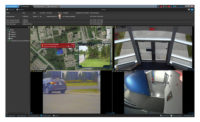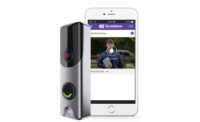As Jim McMullen, president and chief operating officer of Williamstown, N.J.-based COPS Monitoring, says, for decades, central station communication technology essentially consisted of four main components: phone lines, alarm receiver hardware, monitoring software platforms, and telephone systems.
My, how times have changed.
“The way we monitor has completely changed,” says Marci Zissis, director of customer monitoring center, ADT, Rochester, N.Y. (featured on the cover). “Historically you would go to a box and press a button that would send an alarm. Now everything is more customized to the customer. Before there was just one thing; now we look at everything. The entire customer experience is handled with one agent.” Not only that, but where they monitor has changed, from apartments, to in a vehicle, to personal safety with a smart watch.
Today’s landscape is dramatically more complex, McMullen says. “The explosion of smartphones, smart homes, IP-based alarm communications, and the Internet of Things (IoT) has driven high demand for real-time user connectivity through our proprietary API for both dealers and subscribers.”
As a result of trends and technological advances, the monitoring landscape is changing rapidly.
“Monitoring is transitioning to almost anything of value that can transmit a signal,” says Carolyn Brown, vice president of Security Central, Statesville, N.C. “Therefore we are seeing more atypical requests compared to traditional monitoring. Monitoring is shifting away from the traditional signals of burglar, fire, medical and more toward signals relaying any message of critical value to a customer.”
When it comes to monitoring in the current environment, companies are willing to go to whatever lengths necessary to monitor pretty much anything their customers want monitored.
“We tell our dealers, ‘If it has a sensor, we can monitor it,’” says Kevin McCarthy, national sales manager for Des Plaines, Ill.-based Emergency24.
Essentially, the sky is the limit when it comes to monitoring today.
“The IoT has no limitations and the key is how to properly select, integrate and create beneficial outputs with the data associated with an activity,” says Ty Richmond, president, integrated solutions and technology for Allied Universal, which is based in Santa Ana, Calif., and Conshohocken, Pa.
Following are a few examples of how dealers and monitoring companies are harnessing innovation and thinking outside the box to provide new services that generate additional recurring monthly revenue (RMR).
DIY
In the security industry, the trend that has had the greatest impact on dealers’ bottom lines is the rise of DIY security systems. According to Grant Graham, director of monitoring operations for MONI Smart Security, Farmer’s Branch, Texas, this is the hottest topic in the industry for good reason.
“Many have anxiety about what DIY and the emergence of outside companies into the DIY space mean for the industry,” he says. “MONI has partnered with Nest on this front and we have high hopes that it will translate into success for both companies.”
This is a model other monitoring companies are looking to seize on.
ADT recently announced a DIY product in conjunction with Samsung SmartThings, that is being sold through Best Buy and can be professionally monitored or even monitored on demand. “The Samsung SmartThings product is a huge step forward in technology,” Zissis says. “There are multiple providers trying to be in that security game, including cable and cell phone companies.”
Brown agrees. “Today we are seeing the DIY space boom and the new entrants of non-traditional alarm companies like Google and Nest. Our goal is to capture some of the RMR these devices are generating in our industry and it will be a win-win for both companies.”
The main reason behind providers’ embracing DIY, Graham says, is that from a monitoring perspective, harnessing revenue from DIY systems is not terribly challenging, assuming that a vendor or manufacturer can send a signal in the proper alarm language format. That’s not to say there aren’t challenges with the process.
“The greatest challenge in DIY is the onboarding of the customer into alarm automation,” he says. “With traditional professional installation, a dealer is involved in the installation, training of the customer and onboarding of customer data into the center. With DIY, the customer comes direct to the monitoring company so ensuring that there is proper training and onboarding through a combination of digital offerings and remote support provides a unique challenge.”
With this in mind, monitoring companies can help dealers find an entry into the DIY space, which can allow them to reap the benefits of RMR from a non-traditional source — one that would otherwise be direct competition for them.
“I believe that most dealers will be forced to offer a combination of DIY products and professional installation products,” Graham says. “A full suite of services to fit all the customer needs will be necessary if we wish to remain in all market segments.”
Thankfully, Brown says, there are multiple options out there that provide at least some level of participation for dealers looking for DIY RMR.
Network security
According to Don Young, chief information officer for Boca Raton, Fla.-based ADT (SDM’s 2017 Dealer of the Year), protecting end users’ networks is becoming just as important as ensuring their physical safety, which is why ADT launched a cyber security service last year for small businesses and commercial customers in four cities across the country. The company plans to expand this offering to residential customers nationwide in 2018.
In partnership with Cisco, BitDefender and others, ADT has created a custom solution that helps monitor network communication, manage antivirus software and create a cloud-based backup to ensure business continuity. With the ransomware industry hovering around $1 billion, ADT says this is a major security concern for all, particularly business owners.
The service is provided through ADT’s network operations monitoring center (NOC) located in Delaware, which is primarily focused on providing real-time monitoring of IT-sensitive systems, including up/down status and network performance metrics. In addition to monitoring these systems for performance and potential problems, the center also designs, installs and commissions LAN/WAN networks for companies that either do not have the internal resources to accomplish this in-house or for those who want a dedicated security-only network.
Customers are notified of potential problems with networks or components proactively before they can become major issues, and the NOC is also able to provide health monitoring for other network-connected devices, such as IP cameras and recorders.
“What we do there that is different is we actually do forensic reviews of people’s networks and IT architectures to see if they currently are susceptible or exposed to any kind of unwanted intrusion,” Young says. “It could be malware or phishing.”
This monitoring service, particularly the forensic component, provides ADT’s customers with the peace of mind they need in the face of today’s environment, where network attacks and breaches have become all too commonplace, Young says.
“Everyone is trying to go to bed feeling comfortable that they just deployed firewalls to prevent future attack,” he says. “Once the attack happens it doesn’t always show itself the day the attack happened. This whole forensic approach making sure people can sleep at night is where we come in.”
Safe haven
Emergency24 offers a “safe haven” service designed to help mothers and/or fathers who feel they cannot care for their children. These locations, usually found at emergency agencies, provide an environmentally controlled chamber in which a parent can safely and legally leave a child to be given up for adoption with no questions asked.
The system is triggered by a contact and motion detector that alerts an operator in the monitoring center of the need for response upon activation, allowing authorized individuals to retrieve the child immediately.
“While it’s sad to think that this type of application is needed, we are very happy to be able to help keep that child safe,” McCarthy says.
Expanding mobile capabilities
While mobile applications are nothing new, Guardian Protection Services, Warrendale, Pa., is working to incorporate two new services into those applications: mobile panic devices and remote cancellation, says Jason Bradley, vice president of customer service.
Rather than being GPS-enabled panic devices, Guardian’s service is used to alert the monitoring center to dispatch authorities to the monitored location using their mobile phone. One potential use for this service is to provide peace of mind to parents of latchkey children who may be home alone.
“Kids will often ring their parents first if there’s a threat or a problem at the house that needs urgent assistance,” says Bradley. “Besides dialing 911 themselves, the parent can activate the panic button to alert us so we can get the authorities to that location. They can be anywhere and it’s going to offer the interconnectivity between family units to get help when it’s needed.”
The mobile cancellation service allows end users to cancel the monitoring center’s response via their smartphone. While traditional keypad-based cancellation will continue to exist, Bradley says mobile cancellation will grow tremendously in the near future.
The main reason behind both services is to improve customer experience by transitioning a traditionally non-interactive alarm system into something more interactive connected to static panels.
“By virtue of moving more to that interactive, cloud-based experience, it’s going to improve the customer experiences interacting with security and home automation even more,” Bradley says. “It’s going to give them much more utilization out of that panel and provide a stronger return for that monthly bill they receive, so that we can integrate our services further into their day-to-day life.”
The main challenge, Bradley says, will be educating customers on the potential downside.
“While the applications are very solid and they work and offer tremendous benefits, it’s going to be the education of that end user that what actions they’re taking in those applications have consequences and results, such as utilizing a remote cancel feature on an alarm when maybe there is something happening at the home. They need to be aware of the dangers of just pressing a button. In today’s day and age, we’re very used to point-and-click but we have to understand the consequences of that in this situation. I think customer education will be highly beneficial and needed.”
GSOC
Several of the newer monitoring services Allied Universal offers its customers are delivered through the company’s global security operations center as a service (GSOCaaS). Under the umbrella of this service, the company provides threat intelligence/situational awareness data, critical event activity/management, security data for corporate and company travelers and more.
The main driver behind this service is the vital need for organizations to be prepared for threats and mitigate risk, which is where real-time situational intelligence comes in. This information is critical for helping security professionals make the best decisions possible regarding the safety of employees, as well as to ensure operational continuity, in the event of a crisis.
“We’ve become a higher-value provider to our customers due to the extremely important role we have in their physical and operational security sphere,” Richmond says. “We also are now extremely important to clients’ big data management and predictive analysis processing, which is key to their proactive and reactive response to risk mitigation, as well as being a much closer partner and trusted advisor when it comes to helping build and deploy more effective and efficient solutions.”
Overcoming hurdles
New and innovative monitoring services like these and others provide dealers and monitoring companies with numerous benefits, but they are not without hurdles to overcome first.
“The biggest challenge to offering these unique services is simply making alarm contractors aware that they exist,” McCarthy says. “Many of the new services we develop for the industry come as a result of a dealer asking us if we can do something for them. Almost always, the answer is yes.”
Change will continue to be a constant in the monitoring space, which will require new attitudes about the traditional models and new opportunities technology provides.
“The industry needs to think differently, adapt quickly and continue to be flexible to change that is being driven by the greatest technology advancements in our lifetime,” Richmond says. “The firms that can solve problems and create managed services that scale and deliver the value beyond single product or service area will have much more success and sustainability.”
Brown says dealers and monitoring companies have to create their opportunities, as the possibilities are endless, leaving it up to the dealer to be innovative and create new markets and revenue streams.
“The monitoring industry as we know it is evolving into a different space than 20 years ago or even 10 years ago,” she says. “Technology is giving us more options for monitoring solutions to present to customers and even change the B2B relationship and have a connection with the end users, which we historically haven’t had. It is exciting but companies must not get complacent and adapt with the change.”
Monitor Your Own or Work With a Third-Party Provider?
“Alarm contractors who operate their own central station are leaving money on the table and not able to offer the full range of services that other dealers offer,” says Kevin McCarthy of Emergency24. “Take a moment to watch your competitors’ TV advertisements and their focus on selling smart home systems. Sure, you can match the capabilities today — but at what cost per subscriber? And will the next technological breakthrough cost too much for your company to remain competitive?”
In short, trends in technology can make it difficult for smaller central stations to compete and provide dealers with the range of services a larger provider may be able to deliver, says COPS Monitoring’s Jim McMullen.
“A central station in today’s world must have the resources and expertise to make the necessary initial and constant ongoing investments in alarm receiving technology, broadband connectivity, telephony components, routers, firewalls, network switches, load balancers, and mainframes,” he says. “In addition, they must also possess the sophistication needed to understand and manage Virtual Private Networks (VPNs), Application Programming Interfaces (APIs), Software as a Service (SaaS), Autonomous Systems Numbers (ASN), Domain Name System (DNS) management, and be well-versed in cyber security and several other highly technical components.”
With a third-party monitoring company, on the other hand, the list of potential services a dealer can easily offer is long and brings even greater revenue potential, says Grant Graham of MONI Security Services.
“The main point that I would make to a dealer who doesn’t operate a CS is that they can focus on sales, installation and service, while a professional monitoring service can work for them on servicing the client’s monitoring needs,” he says. “Additionally, a pro-monitoring outfit will keep track of industry trends and should be able to market to the dealer where those trends are.”
The cloud and monitoring
Given the increased use and acceptance of the cloud in everyday life, it’s worth asking what that technology may mean for monitoring in general. Below are three industry insiders’ takes on that question.
Carolyn Brown, Security Central: “It means more options, but central stations like Security Central will not be able to see the true benefit of the cloud at this time because of our size and the impact that would have on a cloud space. In the future as this becomes a more widely used option, it is a great option for smaller central stations, allowing them to lower technology costs.”
Grant Graham, MONI Smart Security: “Central stations will need to make a decision: host internally or externally. This is a hurdle at some companies because the idea of not hosting everything within the walls of a NRTL (nationally recognized testing laboratory)-listed center is foreign. This is, however, the way the industry is heading. Even central stations are entertaining using farmed out hosting for their receiver and monitoring equipment. It will also be very interesting to see how NRTLs handle technology in their writing of standards.”
Ty Richmond, Allied Universal: “From a digital transformation standpoint, it definitely creates a shift in normal thinking about redundancy, resource allocation and different models of delivery. In the future, monitoring could have various forms of support models and distinct areas of both specialization and consolidation and convergence.”
Remote robots
One of the more innovative new monitoring services in the industry is Allied Universal’s anomaly detection service, which is provided using Knightscope Autonomous Data Machines — aka robots. Rather than requiring someone to remotely control the robots, they operate autonomously within a geo-fenced area to provide alerts generated by a number of factors, including thermal imaging, people detection, license plate recognition, audio recording and 360-deg. view. The robots also provide two-way intercom and live and pre-recorded audio broadcast for communicating with individuals remotely.
By performing more monotonous, computationally heavy and even dangerous work, the robots provide their human counterparts with the freedom to focus on decision-making and situational analysis based on conditions and/or events at the remote location.






